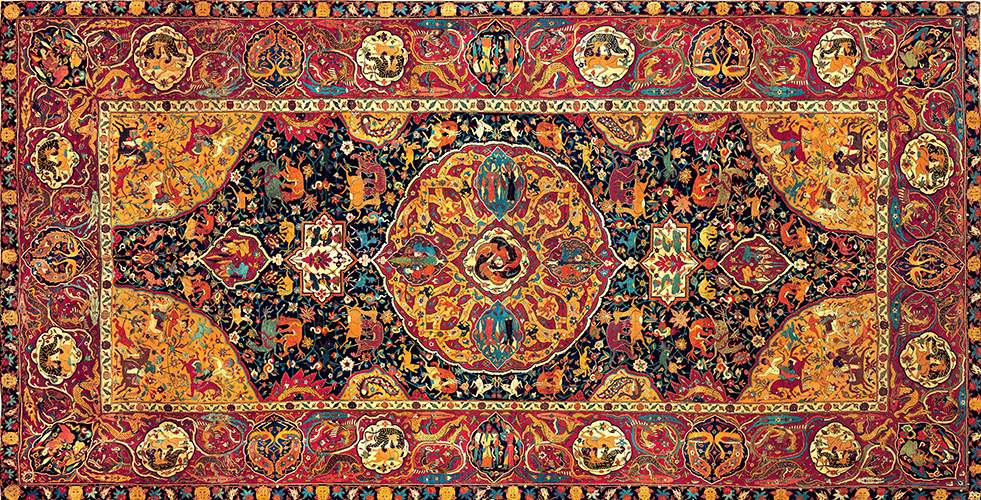From Nov. 11, 2022 to Feb. 12, 2023, the halls of Palazzo Rosso in Genoa will host “the most beautiful carpets in the world” for the exhibition The Magnificent Sanguszko Carpets. The World’s Most Beautiful Carpets: masterpieces from 16th-century Persia, curated by Michael Franses.
For the first time in Italy, a significant number of Persian carpets from the 16th century will be presented simultaneously to the public. The first part of the exhibition will bring together one of the most important groups of Safavid carpets, consisting of artifacts produced in the city of Kerman and named Sanguszko, after the Polish noble family that owned one of the best-known examples.
These are a series of works of art created in the Safavid period, in the mid-16th century, by artists of the highest caliber. Made using the knotting technique, employing the highest quality wool, cotton and silk yarns, these carpets feature a wide variety of figurations alluding to the beauty of the earth and otherworldly life. True portable gardens, parks of delight populated with animals, angels and musicians, they were considered worthy of the most sumptuous mansions.
Of the fourteen Sanguszkos still in existence, eight will be on view in the rooms on the second floor of Palazzo Rosso, while the other six, to give a complete picture, will be presented in the form of reproductions. On the second floor, the public will be able to admire fifteen more carpets, including nine in original and six in the form of reproductions, from both Kerman and other Persian centers of production, such as Tabriz or Mashhad. Datable to the 16th and 17th centuries, these artifacts, some of which have in the past been juxtaposed with the Sanguszko group, will help broaden the panorama of carpet art in the Safavid era, offering visitors an opportunity to discover other types and different types of decorations.
The exhibition stems from the restoration, sponsored by the Bruschettini Foundation, of one of the Sanguszko carpets, owned by the Instituto Valencia de Don Juan in Madrid, and is dedicated to the memory of Alessandro Bruschettini, a Genoese intellectual and collector who recently passed away. Since the centuries of the Middle Ages, the city of Genoa has been a nerve center for the trade in oriental carpets, displayed by the wealthiest families in their residences and intended to embellish the most important buildings. In conjunction with the initiative, the palace’s sumptuous halls, thanks to the willingness of distinguished public and private lenders, including the Louvre Museum, The Textile Museum of Lyon, the Museum of Islamic Art in Berlin, the Poldi Pezzoli Museum in Milan, the Thyssen-Bornemisza Foundation, the Instituto Valencia de Don Juan, and the Bruschettini Foundation for Islamic and Asian Art itself, will once again be able to host these works.
In close connection with the Palazzo Rosso initiative, Palazzo Bianco will host during the same period the exhibition Persian Figures. Rubens, the Genoese and Safavid Art, curated by Loredana Pessa. The subject of the exhibition itinerary is a series of valuable Persian works from the Safavid period, dating from the 16th and early 17th centuries. The silk textiles and miniatures from private collections are united by the presence of depictions of figures in Persian costume that echo the subjects depicted on the carpets on display at Palazzo Rosso.
In the early seventeenth century, these exquisite and exotic figures also fascinated Pieter Paul Rubens, as evidenced by a number of drawings now in the British Museum, the reproduction of which can be seen in the exhibition, along with that of the many paintings in which the great Flemish master included Persian costumes, carpets and textiles.
Also on display at the same venue is a Persian miniature with a biblical subject(Susanna and the Old Men), executed by a Persian painter inspired precisely by a Rubens model, evidence of the cross-cultural dialogue that also deeply involved artists working within the Safavid empire. Interest in Safavid Persia was also shared by many Genoese, in keeping with a tradition of relations with this part of the Eastern world dating back to the Middle Ages. The city, which in 1605 welcomed Anthony Sherley, the famous English ambassador of Shah Abbas, Robert’s brother, portrayed by Anton van Dyck in 1622 in oriental dress, continued to be an important junction of trade with the Middle and Far East, and the influx of valuable goods from Persia was also guaranteed thanks to the intermediation of Armenian merchants.
A section of the exhibition is devoted to the presence of carpets, textiles and other Persian artifacts in aristocratic dwellings, attested by paintings of the period and archival documents, while the curiosity and attention of the Genoese ruling class to the Safavid Empire, in competition with the Ottoman Empire, is also revealed by the numerous printed works devoted to Persian history and customs from the libraries of aristocratic families.
Both exhibitions are produced in collaboration with the Bruschettini Foundation for Islamic and Asian Art and are part of the project Genoa for Rubens. A Network, which was created around the Rubens in Genoa exhibition running until Jan. 22, 2023 at the Palazzo Ducale.
The exhibitions are both open Tuesday through Friday from 9 a.m. to 6:30 p.m., Saturday and Sunday from 9:30 a.m. to 6:30 p.m.
Image: Sanguszko Carpet (1535-1550; Shiga, Miho Museum)
 |
| The world's most beautiful carpets and works of Safavid art arrive in Genoa |
Warning: the translation into English of the original Italian article was created using automatic tools. We undertake to review all articles, but we do not guarantee the total absence of inaccuracies in the translation due to the program. You can find the original by clicking on the ITA button. If you find any mistake,please contact us.